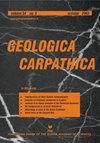中新世下鲕粒岩和巨型鲕粒岩:下奥地利州始新世沃斯贝格灰岩赋有及其对沃斯贝格南部-Ždánice单元结构组成的影响的新解释
IF 1.5
4区 地球科学
Q4 GEOSCIENCES, MULTIDISCIPLINARY
引用次数: 0
摘要
Waschberg–ždánice单元连接阿尔卑斯山和喀尔巴阡山造山带。其复杂的构造和沉积构造缺乏现代解释,尤其是在奥地利部分。近年来,Waschberg–ždánice单元的南端已进行了详细的地质测绘。Waschberg石灰岩的九个大型矿点(km大小),特别是在Waschberg、Michelberg、Praunsberg和一些未命名的地方,继续进入大范围的滑变带,并与之一致。因此,它们被解释为巨大的滑石岩,代表了与相邻滑石岩同期的海底物质输送过程的产物。没有发现大规模叠瓦状构造(重复序列)的迹象,也没有发现构造褶皱的解释。在详细的地质填图基础上,介绍了一些以前未知的构造元素,如Haselbach楔和“紧缩带”。Waschberg石灰岩本身是一种外来混合沉积物(高密度碎屑岩和浊积岩),包含不同年龄的浅水底栖生物(如Nummulites)和深水浮游有孔虫。Waschberg石灰岩的形成和最终沉积包括伊普尔阶大型有孔虫和其他生物颗粒在伊普尔阶/基底-卢特阶盆地中的沉积、向西北方向的分离和迁移、在埃格尔阶或基底-埃根堡阶前深部与结晶基底碎片和复理石成分的混合、在逆冲前缘的不稳定斜坡上的暴露,最后是埃根堡期奥里托斯特罗姆和瓦施伯格石灰岩巨型奥里托斯特的动员和向盆地输送。在中新世早期,滑覆岩和巨型滑覆岩的形成可能表明逆冲作用的速度增加或强度更高。本文章由计算机程序翻译,如有差异,请以英文原文为准。
Lower Miocene olistostromes and giant-olistoliths: A new interpretation of the Eocene Waschberg Limestone occurrences and consequences for the structural composition of the southern Waschberg–Ždánice Unit in Lower Austria
The Waschberg–Ždánice Unit links the Alpine and Carpathian orogens. Its complex structural and sedimentary structures lack a modern interpretation, particularly in the Austrian part. In recent years, the southern end of the Waschberg–Ždánice Unit has been geologically mapped in detail. Nine large occurrences (km-size) of the Waschberg Limestone, particularly at Waschberg, Michelberg, Praunsberg, and at some unnamed places continue into and strike in line with the widespread olistostromes. They are consequently interpreted as giant-olistoliths and represent products of submarine mass transport processes contemporaneous with the adjacent olistostromes. Signs for large-scale imbricate structures (repetitive sequences) or interpretation as tectonic klippen were not found. Based on the detailed geological mapping, some previously unknown structural elements are introduced, such as Haselbach Wedge and ”crunch-zone”. The Waschberg Limestone itself is an allochthonous mixed sediment (high density debrites and turbidites) that contains shallow water benthic (e.g., Nummulites) and deep-water planktic foraminifera of different age. Formation and final deposition of the Waschberg Limestone included sedimentation of Ypresian larger foraminifera and other biogenic grains in an Ypresian/basal Lutetian basin, detachment and transport towards the north-west, mixture with crystalline basement fragments and Flysch components in an Egerian or basal Eggenburgian foredeep, exposure on unstable slopes of the thrust front, and finally mobilization and basinward transport of olistostromes and Waschberg Limestone giant olistoliths during the Eggenburgian. The formation of olistostromes and giant-olistoliths may be indicative for the increased velocity or higher intensity of the thrusting processes during the early Miocene.
求助全文
通过发布文献求助,成功后即可免费获取论文全文。
去求助
来源期刊

Geologica Carpathica
地学-地球科学综合
CiteScore
2.40
自引率
23.10%
发文量
26
审稿时长
>12 weeks
期刊介绍:
GEOLOGICA CARPATHICA covers a wide spectrum of geological disciplines including geodynamics, tectonics and structural geology, volcanology, stratigraphy, geochronology and isotopic geology, karstology, geochemistry, mineralogy, petrology, lithology and sedimentology, paleogeography, paleoecology, paleobiology and paleontology, paleomagnetism, magnetostratigraphy and other branches of applied geophysics, economic and environmental geology, experimental and theoretical geoscientific studies. Geologica Carpathica , with its 60 year old tradition, presents high-quality research papers devoted to all aspects not only of the Alpine-Carpathian-Balkanian geoscience but also with adjacent regions originated from the Mediterranean Tethys and its continental foreland. Geologica Carpathica is an Official Journal of the Carpathian-Balkan Geological Association.
 求助内容:
求助内容: 应助结果提醒方式:
应助结果提醒方式:


